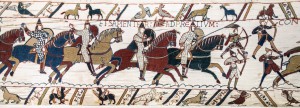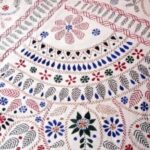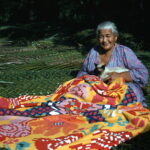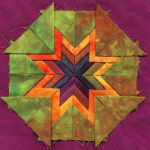In my tutorial “How to Patchwork Quilt” I gave a brief description of patchwork and quilting. This article delves into the history of patchwork quilting.
Ancient Eygpt
The word quilt is derived from the Latin word Culcita, meaning a cushion or mattress that has been stuffed.
Patchwork and Quilting is thought to have been around as far back as 980 BC. A quilted funeral canopy was found in the tomb of the Egyptian queen Queen Esi-mem-kev, who was thought to have lived around 980 BC. Another example is a carved ivory figure discovered in 1903. It was a Pharaoh from the first dynasty of Egypt, (around 3400 BC) who is wearing what appears to be a quilted mantle.
A quilted rug was found in a Scythian chieftain’s tomb. (Koslow Scientific Expedition, 1924 to 1926). Carbon dating indicates the age to be around the 4th or 5th century B.C. and it is believed to be the oldest example of a quilted rug. Once cleaned it was seen to have a beautiful range of colours, soft blue and greens, rich reds and gold. It has an elaborate pattern which is still used in carpets today.
There are only a very few examples from these earlier dates but a good indicator that patchwork and quilting has been around for a very long time!
Medieval and Renaissance Europe
Only the odd item has been found from the medieval period but gives evidence of armour being made of quilted leather, linen padded with rags/straw/sheep’s wool and sometimes reinforced with metal. These were thought to have been worn by William the Conqueror and his Crusaders, not just for protection but also for warmth.
(Bayeux Tapestry scene51 Battle of Hastings Norman knights and archers” by Myrabella – Own work. Licensed under Public domain via Wikimedia Commons)

In Europe, as the climate became colder the use of quilts for bedding became more popular. This gave rise to the development of embellishing simple cloth with design and decorative stitches. Pilgrims to America took this tradition of making quilts this way with them.
As time moved on to the Renaissance period, decorative quilted clothing became more popular and quilted bed covers were a luxury items used among the wealthy.
17th Century Onwards
From the 17th century onwards we know more about the history of patchwork quilting as more items have survived. The earliest surviving dated patchwork bedcover is known as the 1780 silk coverlet. It was discovered in 2000 and now belongs to the Quilters Guild of the British Isles. It has the initials E H and the date 1718 in the centre block but no details about the maker can be found. The blocks have motifs with flowers, hearts, pheasants, deer, cats, swans, lions and a unicorn and geometric designs. It is a beautiful piece of work, unfortunately due to copyright I can’t show it here but follow the link above and you can see it in all its glory!
Averil Colby
Averil Colby (1900–1983) was an influential quilter well known for her “foraging” of fabrics; an early upcycler! She believed that patchwork was a great way to teach hand sewing and didn’t believe in using a machine. When she died a collection of her items, which included a selection of floral fabrics was given to The Quilters Guild. It was her foraging for these fabric samples that helped historians date old quilts, most of which were never signed or dated. (http://www.quiltmuseum.org.uk).
The purpose of patchwork quilting started off for practical reasons. It’s gradually become one of the most popular sewing hobbies today with thousands of patchwork and quilting groups all over the world.

Doing the research into the history of patchwork quilting, plus seeing the many beautiful examples has inspired me to learn more about this wonderful hobby! If you want to try a simple patchwork baby quilt check out my How to Patchwork Quilt tutorial.





Just goes to show that patchwork quilting doesn’t go out of style! What an interesting look back into history, thank you for providing such a well-researched post!
Thanks Jolie. Researching the history of patchwork quilting was absorbing to say the least and I didn’t really cover the rise in popularity in America. Lot’s more interesting things to read about! 🙂
Wow! I never knew all of this did exist. I really appreciate you taking out time and providing us with such knowledge! 😀
Thank you Srijan! I found the history of patchwork quilting very interesting, never thought the craft was as old as it was. 🙂
My grandma loves this stuff. Definately gonna forward her this article 🙂
Thanks Jesse. It’s not just Grandmas doing patchwork quilting these days, I’ve got my grandaughter started on a quilt! 🙂
Hi Kathy,
I really enjoyed learning the history of patchwork quilting. I am in awe of the makers of these. My grandmother helped me make one for my daughter when she was just a couple months old. Sadly, in all of our moves, it got misplaced.
Angela
Thanks Angela, some of these patchwork quilts are simply beautiful. It’s a shame you lost your daughter’s quilt, you could make another for the Grandbabies though. Then they will have their heirloom to pass on. 🙂
Hello
I thought quilts were just something our grandmothers did for hobbies…
Great article… Very informative site!
Patchwork quilting is a HUGE thing now, people of all ages have taken up the hobby! Thanks for the positive comment. 🙂
wow! I didn’t know there was so much history to quilting, it made for an interesting read! And I love quilts!
Thanks Juli, it was interesting doing research into the history of patchwork quilting. I had no idea it went away back to Egyptian times! 🙂